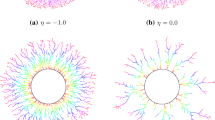Abstract
Suppose there is a Poisson process of points X i on the line. Starting at time zero, a grain begins to grow from each point X i , growing at rate A i to the left and rate B i to the right, with the pairs (A i , B i ) being i.i.d. A grain stops growing as soon as it touches another grain. When all growth stops, the line consists of covered intervals (made up of contiguous grains) separated by gaps. We show (i) a fraction 1/e of the line remains uncovered, (ii) the fraction of covered intervals which contain exactly k grains is (k−1)/k!, (iii) the length of a covered interval containing k grains has a gamma(k−1) distribution, (iv) the distribution of the grain sizes depends only on the distribution of the total growth rate A i +B i , and other results. Similar theorems are obtained for growth processes on a circle; in this case we need only assume the pairs (A i , B i ) are exchangeable. These results extend those of Daley, et al. (2000) who studied the case where A i =B i =1. Simulation results are given to illustrate the various theorems.
Similar content being viewed by others
References
D. J. Daley, C. L. Mallows, and L. A. Shepp, “A one-dimensional Poisson growth model with non-overlapping intervals,” Stochastic Processes and their Applications vol. 90 pp. 223–241, 2000.
D. J. Daley, D. Stoyan, and H. Stoyan, “The volume fraction of a Poisson germ model with maximally non-overlapping spherical grains,” Adv. Appl. Prob. vol. 31 pp. 610–624, 1999.
O. Häggström and R. Meester, “Nearest neighbor and hard sphere models in continuum percolation,” Random Structures and Algorithms vol. 9 pp. 295–315, 1996.
F. W. Huffer, “One-dimensional Poisson growth models with random and asymmetric growth,” Technical report, Department of Statistics, Florida State University, 2002.
M. O'Hely and A. Sudbury, “The annihilating process,” Journal of Applied Probability vol. 38 pp. 223–231, 2001.
H. Sackrowitz and E. Samuel-Cahn, “Estimation of the mean of a selected negative exponential population,” J. R. Statist. Soc. B vol. 46 pp. 242–249, 1984.
A. Sudbury, “Inclusion-exclusion methods for treating annihilating and deposition processes,” Journal of Applied Probability vol. 39 pp. 466–478, 2002.
Author information
Authors and Affiliations
Rights and permissions
About this article
Cite this article
Huffer, F.W. One-Dimensional Poisson Growth Models With Random and Asymmetric Growth. Methodology and Computing in Applied Probability 4, 257–278 (2002). https://doi.org/10.1023/A:1022585818488
Issue Date:
DOI: https://doi.org/10.1023/A:1022585818488




